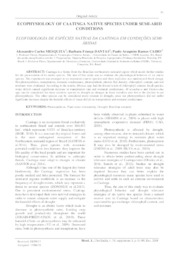Ecophysiology of Caatinga native species under semi-arid conditions.
Ecophysiology of Caatinga native species under semi-arid conditions.
Author(s): MESQUITA, A. C.; DANTAS, B. F.; CAIRO, P. A. R.
Summary: Caatinga is a biome from the Brazilian northeastern semiarid region which needs further studies for the preservation of its native species. The aim of this study was to evaluate the physiological behavior of six native species. The experiment was arranged in six treatments (native species) and three replicates in a randomized block design. Net photosynthesis, transpiration, stomatal conductance, photosynthetic photon flux density, chlorophyll content, and soil moisture were evaluated. According to the results, Mimosa spp. had the lowest levels of chlorophyll content. In all species, water deficit caused significant decrease in transpiration rate and stomatal conductance. M urundeuva and Cnidoscolus spp. can be considered the most sensitive species to drought as changes in those variables also led to the decline in net photosynthesis. The other species can be considered more tolerant to drought, since net photosynthesis did not suffer significant decrease despite the harmful effects of water deficit on transpiration and stomatal conductance.
Publication year: 2018
Types of publication: Journal article
Unit: Embrapa Semi-arid Region
Observation
Some of Embrapa's publications are published as ePub files. To read them, use or download one of the following free software options to your computer or mobile device. Android: Google Play Books; IOS: iBooks; Windows and Linux: Calibre.
Access other publications
Access the Agricultural Research Database (BDPA) to consult Embrapa's full library collection and records.
Visit Embrapa Bookstore to purchase books and other publications sold by Embrapa.

